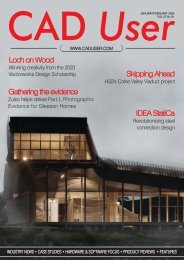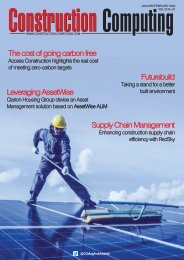Create successful ePaper yourself
Turn your PDF publications into a flip-book with our unique Google optimized e-Paper software.
INDUSTRY comment<br />
How technology collaboration is<br />
driving Net-Zero Carbon success<br />
By Mark Coates, International Director of Public Policy and<br />
Advocacy, Bentley Systems<br />
The UK will not achieve its 2050<br />
carbon emissions targets if it<br />
continues to follow the current<br />
stuttering path. Picking off the low<br />
hanging fruit - LED lighting, promoting<br />
electric cars, or changing energy provider<br />
- will be insufficient.<br />
The built environment seems a natural<br />
place to start, an industry that contributes<br />
to around 40% of global carbon emissions.<br />
Typically, over 80% of the emissions are<br />
found within the operational phase of a<br />
building's lifecycle, and the remaining 20%<br />
are split across design and build phase<br />
and the decommission/end-of-life phase.<br />
If we take the example of a hospital from<br />
an operational perspective, many<br />
different asset fields contribute to its<br />
overall carbon footprint. They include<br />
catering, waste management, cleaning,<br />
transport, heating/cooling, lighting,<br />
fridges, and medical equipment, which<br />
are spread across the physical hospital<br />
footprint of buildings, wings, floors,<br />
rooms, and theatres.<br />
In the case of the NHS, it is estimated<br />
that over 60% of its carbon footprint is<br />
within Scope 3: supply chain and partners.<br />
Although carbon emission figures may<br />
differ for other organisations, trends are<br />
generally similar, so our area of focus<br />
should be clear: the operational phase. We<br />
must also focus on ensuring that primary<br />
assets and services, as well as their supply<br />
chain, are appropriately measured,<br />
managed, controlled, and improved.<br />
DATA, DATA, AND MORE DATA<br />
All too often, static and active data from<br />
disjointed processes and disparate<br />
unconnected solutions are kept in silos or<br />
not maintained throughout the whole<br />
lifecycle. This disconnect prevents data<br />
from being used for continuous<br />
improvement.<br />
For new build capital projects, static data<br />
is usually held in CAD, BIM, CDEs<br />
(common data environments), and asset<br />
management (CAFM, CMMS) solutions.<br />
Active data usually comes from sources<br />
such as IoT sensing, BMS, and SCADA<br />
solutions, predominately found once the<br />
asset is in use in the operational phase.<br />
But the importance of interoperability, or<br />
at the very least defining a migration<br />
roadmap to more modern systems better<br />
suited to an interoperable environment,<br />
must be stressed. Gap analysis can help<br />
us better understand incumbent<br />
technology, people and processes,<br />
helping deploy and integrate a suitable<br />
smart building environment.<br />
Only when these projects are supported<br />
by an ecosystem of Subject Matter Experts<br />
(SMEs) for disciplines that share the same<br />
vision and objective of an interoperable<br />
environment generating reusable data for<br />
the client's desired business outcomes<br />
can we hope to achieve Net-Zero Carbon<br />
(NZC) outcomes.<br />
Sharing and merging data from different<br />
solutions is critical. For example, why heat<br />
and light a room if it's not being used? This<br />
scenario requires static data, such as<br />
room, dimensions, and location, and<br />
active data such as temperature, energy<br />
consumption, and occupancy. The positive<br />
impact on NZC targets would be extremely<br />
significant if owner-operators and<br />
engineering, architecture, and construction<br />
(AEC) partners adopted open<br />
interoperable solutions to ensure shared,<br />
non-siloed data can be used to achieve<br />
desired business outcomes such as NZC.<br />
Why do solutions need to work together?<br />
Simply put, data-driven decision-making<br />
opens up countless possibilities to reduce<br />
a carbon footprint, but we can't get there<br />
by working as an island. We need to bring<br />
together static and active data to form part<br />
of smart sustainability algorithms targeted<br />
to reduce direct and indirect emissions.<br />
The right questions of who, why, when,<br />
and how assets and locations are being<br />
used must be asked and applied to<br />
merged data sources to obtain insights<br />
12<br />
<strong>Jan</strong>uary/<strong>Feb</strong>ruary <strong>2022</strong>

















